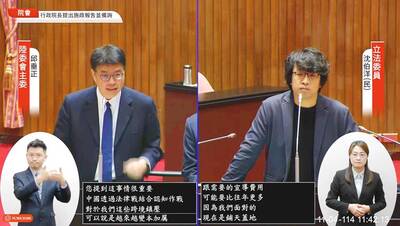The US and South Korea broke through a three-year deadlock on Friday to seal a sweeping free-trade agreement (FTA), which US President Barack Obama hoped would renew US leadership in Asia.
The agreement lifts tariffs on 95 percent of goods between the countries within five years, in what would be the largest US trade pact since the North American Free Trade Agreement with Canada and Mexico in 1994.
After nearly four days of talks in suburban Washington, negotiators cleared a key hurdle by letting the US move more slowly on lifting duties on South Korean cars after US carmakers feared a flood of imports.
The deal still needs ratification by the two countries’ legislatures. Obama won early support from a labor-backed congressman and the Ford Motor Co, former staunch opponents of the deal.
As a senator, Obama was a critic of the deal first negotiated in 2007 under then-US president George W. Bush. But on Friday, Obama said his team reached “the best deal for American workers and corporations,” saying it would create 70,000 US jobs through new exports — an estimate disputed by critics.
“It deepens the strong alliance between the United States and the Republic of Korea and reinforces American leadership in the Asia Pacific,” Obama said in a statement.
In Seoul, South Korean President Lee Myung-bak said the agreement would bring “huge benefit” to South Korea, which has embraced free trade deals as a strategy to promote an economy long in the shadow of economic giants Japan and China.
“When the FTA takes effect, South Korea will be the first country in the world that will have signed free trade deals with the United States, the EU and ASEAN and India,” he added.
Under the renegotiated agreement, the US will be allowed to keep its 2.5 percent tariff for five years, while South Korea would immediately cut its tariff in half to 4 percent. Both sides would eliminate tariffs after five years.
US officials said Seoul would also ease car safety and environmental standards that US automakers contend are a thinly disguised way to stifle foreign competitors through arbitrary requirements.
The revised agreement would let each US automaker export 25,000 cars per year that meet only US safety requirements — four times the current level.
Mitch McConnell, the top Republican senator, and Representative Sandy Levin, a Democrat from the auto manufacturing state of Michigan who is often critical of free trade deals, came out in support of the new agreement.

CALL FOR SUPPORT: President William Lai called on lawmakers across party lines to ensure the livelihood of Taiwanese and that national security is protected President William Lai (賴清德) yesterday called for bipartisan support for Taiwan’s investment in self-defense capabilities at the christening and launch of two coast guard vessels at CSBC Corp, Taiwan’s (台灣國際造船) shipyard in Kaohsiung. The Taipei (台北) is the fourth and final ship of the Chiayi-class offshore patrol vessels, and the Siraya (西拉雅) is the Coast Guard Administration’s (CGA) first-ever ocean patrol vessel, the government said. The Taipei is the fourth and final ship of the Chiayi-class offshore patrol vessels with a displacement of about 4,000 tonnes, Lai said. This ship class was ordered as a result of former president Tsai Ing-wen’s (蔡英文) 2018

‘SECRETS’: While saying China would not attack during his presidency, Donald Trump declined to say how Washington would respond if Beijing were to take military action US President Donald Trump said that China would not take military action against Taiwan while he is president, as the Chinese leaders “know the consequences.” Trump made the statement during an interview on CBS’ 60 Minutes program that aired on Sunday, a few days after his meeting with Chinese President Xi Jinping (習近平) in South Korea. “He [Xi] has openly said, and his people have openly said at meetings, ‘we would never do anything while President Trump is president,’ because they know the consequences,” Trump said in the interview. However, he repeatedly declined to say exactly how Washington would respond in

WARFARE: All sectors of society should recognize, unite, and collectively resist and condemn Beijing’s cross-border suppression, MAC Minister Chiu Chui-cheng said The number of Taiwanese detained because of legal affairs by Chinese authorities has tripled this year, as Beijing intensified its intimidation and division of Taiwanese by combining lawfare and cognitive warfare, the Mainland Affairs Council (MAC) said yesterday. MAC Minister Chiu Chui-cheng (邱垂正) made the statement in response to questions by Democratic Progressive Party (DPP) Legislator Puma Shen (沈柏洋) about the government’s response to counter Chinese public opinion warfare, lawfare and psychological warfare. Shen said he is also being investigated by China for promoting “Taiwanese independence.” He was referring to a report published on Tuesday last week by China’s state-run Xinhua news agency,

‘ADDITIONAL CONDITION’: Taiwan will work with like-minded countries to protect its right to participate in next year’s meeting, the foreign ministry said The US will “continue to press China for security arrangements and protocols that safeguard all participants when attending APEC meetings in China,” a US Department of State spokesperson said yesterday, after Beijing suggested that members must adhere to its “one China principle” to participate. “The United States insists on the full and equal participation of all APEC member economies — including Taiwan — consistent with APEC’s guidelines, rules and established practice, as affirmed by China in its offer to host in 2026,” the unnamed spokesperson said in response to media queries about China putting a “one China” principle condition on Taiwan’s